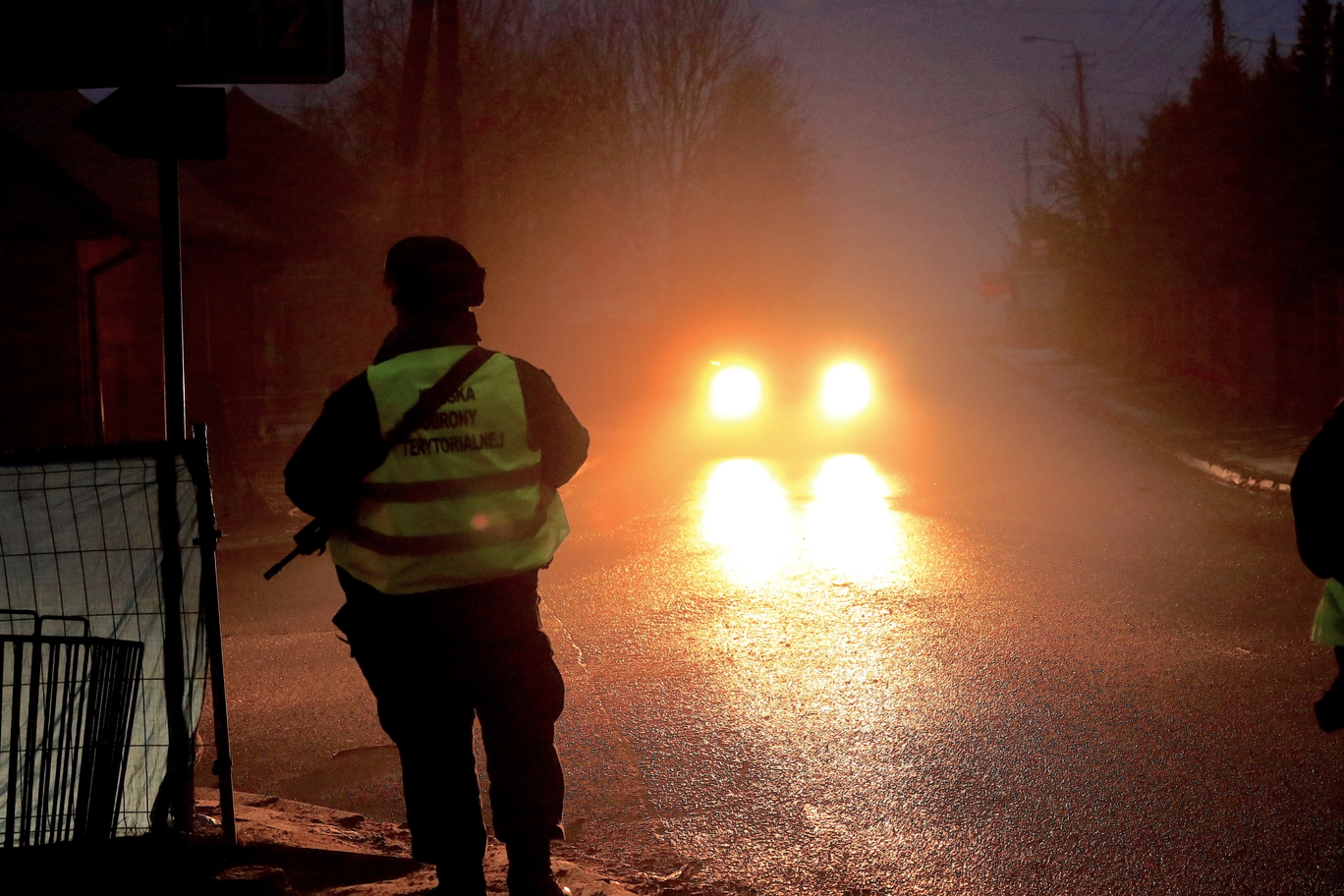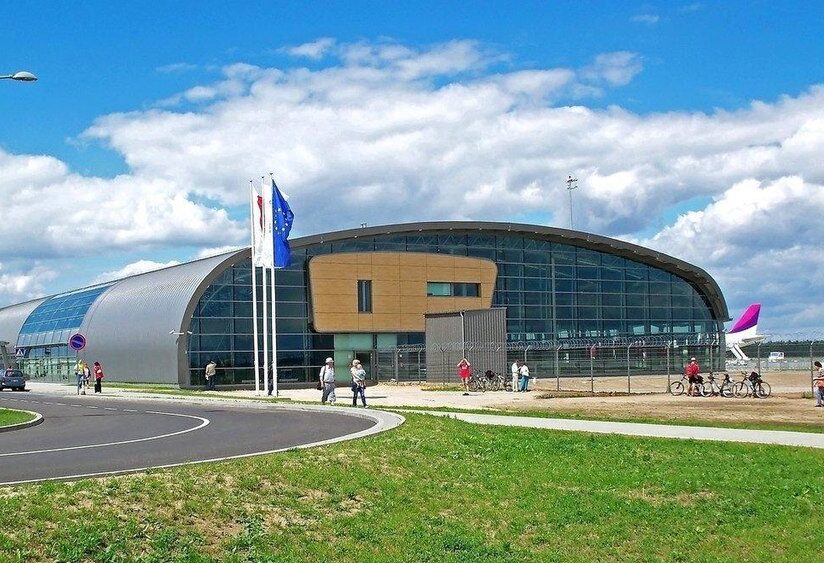By Michał Kranz
Jakub Sypiański, a volunteer translator with the humanitarian coalition Grupa Granica, was driving through Michałowo in Podlasie, Poland shortly after midnight on 26 November when a vehicle with a blue light inside it signalled to him to pull over. Armed men in military uniforms emerged and asked Sypiański to roll down his window, which he said he did while reaching for his cell phone to turn off a podcast he had been listening to.
Suddenly, according to Sypiański, the armed men forced his door open and started pulling him out by his legs, all while yelling expletives at him. They eventually let go, and Sypiański began recording audio of the interaction on his phone.
The transcript of the recording, which was shared with Notes from Poland, captures the armed men interrogating Sypiański but not once identifying themselves or giving a concrete reason for the stop. Only later did Sypiański learn that the men who stopped him were members of Poland’s Territorial Defence Forces (TDF, also known by its Polish initials WOT), the newest branch of the Polish military, founded in 2017.
“Only once before in my life had I felt so afraid, and it was in Lebanon when Hezbollah was attacking me,” Sypiański said.

A Territorial Defence Force soldier near the border (photo: Michał Kranz)
Sypiański’s case has since made headlines in Poland, but his encounter is only the most public example of incidents in which TDF members have been accused of harassing, intimidating, or otherwise overstepping their authority when dealing with humanitarian volunteers, activists, and journalists in Poland’s border region with Belarus in Podlasie since November.
Although allegations from members of civil society organisations have often been denied by the TDF, in some situations like Sypiański’s, audio and video recordings have provided vital pieces of evidence that offer a window into what certain interactions with the TDF have looked like during the ongoing security and migration crisis at the border.
Following Sypiański’s incident, the TDF published their own version of events. Their account accused Sypiański of acting suspiciously before he was stopped, and then turning aggressive and trying to flee in his car after the interaction with the TDF began — claims that Sypiański denies.
Tak wyglądała akcja ratunkowa na bagnach w okolicach zalewu Siemianówka na Podlasiu.
Nasi żołnierze z #4WMBOT wspierali @Straz_Graniczna i strażaków.
Tu więcej: https://t.co/6wk9peSObS#Terytorialsi #SilneWsparcie #PolandHoldtheLine #polandborder #migrants pic.twitter.com/GkwXINM3Yl— Terytorialsi – Zawsze gotowi, zawsze blisko! (@terytorialsi) December 15, 2021
“I have a sense that this is a form of intimidation that they are using as a scare tactic,” said Ania Chmielowska, a press contact with the Ocalenie Foundation, another group working to provide humanitarian assistance in the border region.
Chmielowska recounted interactions with the TDF that volunteers from her own organisation had experienced, in which she alleged that members of the force were aggressive, failed to identify themselves and, on one occasion, demanded phones from the group’s volunteers.
Monika Matus, a press contact with Grupa Granica, described one recent incident on the morning of 3 December in which TDF members arrived at an operations base for Grupa Granica where volunteers had gathered for a meeting.
Matus said the armed TDF servicemen jotted down the licence plate numbers of cars parked at the house, and at one point, began to aim their rifles at volunteers standing outside in the garden in an apparent form of intimidation.
“In theory they could be playing and looking through the sights of their rifles, but it’s kind of hardcore, because in practice you see that someone is aiming a weapon at you,” Matus said. He shared a video of TDF members who arrived that morning with Notes from Poland. However, the footage ends before the men allegedly began threatening volunteers.
Yet in a case which took place on 30 November, Olivia Kortas, a freelance journalist working with German-language media, was able to capture significant portions of an encounter she had with the TDF while reporting on assignment for Y-Kollektiv, a German YouTube channel, in a forest near the emergency zone along Poland’s border with Belarus.
Kortas’s video begins with footage of four or five armed TDF members approaching her, her colleagues, and two local guides and promptly telling them to follow them back to a paved road. TDF soldiers are never heard clearly identifying themselves or stating a reason for this command, and only suggest that Kortas’s crew will be taken to the border guard.
As they walk towards the road, a large military truck and several other TDF members with rifles come into view, and Kortas can be heard telling her cameraman that the soldiers leading them forward have told the men waiting by the truck to put on face coverings. A soldier then commands the group to line up to the right of the truck and to turn off their camera, which is when the video comes to an end.
We have video material that shows the beginning of the situation. It shows how the @terytorialsi soldiers ask for our IDs, how they make us walk towards a street, and how they tell us to stop filming. https://t.co/h3EX96BTbS pic.twitter.com/dKll56jk3w
— Olivia Kortas (@OliviaKortas) November 30, 2021
According to Kortas, what followed was a belittling experience in which 12 armed TDF soldiers surrounded them, yelled at them, and told her cameraman to put his camera down in the middle of the road and step away from it. She said one soldier in particular taunted and mocked Kortas and her group.
“I was angry because of this rude behaviour of those men with their guns standing there having this circle around us and telling me that in the evening I would drink a cup of tea and laugh about all of this, which I would not,” Kortas said.
The situation eventually calmed down, and Kortas and her colleagues were able to leave after the border guard arrived to check their IDs. Kortas, however, is currently in the process of filing a complaint about the encounter.
Marek Pietrzak, the TDF’s spokesperson, claimed that the initial encounter with Kortas took place within the border exclusion zone, which non-residents – including the media and NGOs – are banned from entering without permission. He says the group was then led out of the zone to the road where the border guard eventually met them.
But Kortas claims that in fact the opposite took place – that her party were not in the zone, but were led to its border by TDF members.
When asked about why soldiers did not identify themselves or give a concrete reason for the stop, as evidenced by the video recording, Pietrzak stated that the TDF will view the video if and when it is published to straighten out the facts of the situation.
Regarding other claims against the TDF, Pietrzak said he continues to stand by the version of events the force released about the encounter with Sypiański, adding that he knows and fully trusts the commander of the unit that carried out the stop. Regarding the alleged incident with Grupa Granica on 3 December, Pietrzak said he was not aware of the event, but was hesitant to believe that the TDF would behave in such a manner.
“[This] would be totally unacceptable and would not be tolerated in our ranks,” Pietrzak said. “Our soldiers are fully aware of that, and I’m not able to imagine that such a situation would take place.”
He added that the TDF had approached Grupa Granica to build a cooperative relationship between them as part of outreach efforts in the area, and that for the most part their relations with locals had been well received.
The TDF has drawn controversy since its founding in 2017, when then defence minister, Antoni Macierewicz, argued that it would provide a line of defence against Russian special forces during an invasion.
Critics, however, argued that in such an event the TDF forces would be “cannon fodder”, in the words of one former defence minister. Some have also expressed fears that the force could be used for domestic political purposes by the government.
There has been an uptick in citizen defence and paramilitary movements across Eastern Europe in the last decade, notes Weronika Grzebalska, a sociologist at the Polish Academy of Sciences who studies militarism. Although the TDF is officially a branch of the Polish military, its majority volunteer composition distinguishes it from other parts of the armed forces.
“This is supposed to be an army of neighbours. These are local, regional units that are meant to be citizen soldiers who have normal work and families,” Grzebalska said.
Nevertheless, in Sypiański’s opinion, the force is composed of individuals who are ill equipped to deal with the types of situations they have to confront in the border region. In his view, a re-evaluation of the group’s role is sorely needed.
“This requires a new rethinking of the scope and rules of engagement of these units, as well as the introduction of consequences against individuals whose actions make a joke of the Polish uniform,” Sypiański said. “Unfortunately, this is the kind of group that I chanced upon near Michałowo.”
Main image credit: Olivia Kortas




















